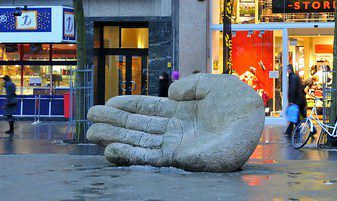Last week, we talked about the importance of our culturally-specific topics, which differ from language to language. As our language of the week this week is Flemish, we took a look at the words and phrases you can learn on the app—and decided to give you a new one and its story, right here!
No matter which language you learn through the uTalk app, as you work through the topics, you’ll come across a unique one. This is our culturally-specific topic, which contains words and phrases that our native speaker translators and voice artists have decided are things you need to know about either the country where a language is spoken, or about the culture surrounding the language itself.
For Flemish, this topic is called België—Belgium. Mostly, the words and phrases involved cover food and dishes you might be likely to encounter in the country, locations around Belgium, or buildings. However, there are also others related to monuments and statues, as well as notable people who are either from that country or speak that language. (Or both!)
While we certainly have a lot of things you need to know in our België topic, we came across a statue—and a story—from the Belgian city of Antwerp that we thought were worth sharing here.
Have you ever heard of a giant named Druon Antigoon?
Who is Druon Antigoon?
The mythical Druon Antigoon was a giant who lived in Antwerp. Now, the river Scheldt runs through Antwerp, so Druon Antigoon took up position on the bridge and took it upon himself to issue tolls to people trying to cross this river.
If people paid, then all was fine; they could cross. If they, however, were unable to or refused to pay, then Druon Antigoon would cut off their hand and throw it into the river.
This went on and on until one day, a Roman soldier by the name of Silvius Brabo arrived. When he heard of the story, he confronted Druon Antigoon and—in a shocking twist—killed the giant and cut off his hand, throwing that into the river instead!
The Brabo statue
Today, the Brabo statue still exists, standing right out in front of Antwerp city hall. It shows Brabo holding the giant’s hand, ready to throw—and if you see it when it’s turned on, you’ll see water shooting from Druon Antigoon’s wrist.
According to folklore, this story is said to be where the name Antwerp originates. Antwerpen, in Flemish, is the equivalent of hand werpen in Dutch–or, hand and throw. It is, however, more likely that the name Antwerp is related to the Latin ante verpia, which means ‘a piece of land in front’. This could refer to land created when the river changed course in the seventh century.
Druon Antigoon and modern-day Antwerp
Cool story, then, but what impact has it had on Antwerp today?
Well, there are a couple of things…
Firstly, there are local biscuits called Antwerpse Handjes (Antwerp’s Hands), which only bakers licensed by the city are allowed to bake. They can also be purchased as chocolates and despite their slightly macabre origins, knowing Belgian chocolate, they’re likely to be very tasty!

Secondly, well, there’s the Hand of Druon Antigoon.
In 1986, French artist Henri de Miller created a sculpture named Écoute. Featuring a giant stone head leaning into a cupped hand, it was placed in front of the Church of St-Eustache in Paris. The head listens to the sounds of the city.
The city of Antwerp bought the sculpture in 1991—but not all of it. They only wanted to purchase the giant stone hand which, in 1992, was placed on Antwerp’s main shopping street, Meir. It is still there today, this giant stone hand, with no base and no head.

Want to know more about Belgian culture?
Then check out our app! You’ll learn what Belgians like to eat, what places in Belgium are called in Flemish, as well as some interesting tourist destinations. And if you’re interested in learning any other languages, you’ll have the chance to learn about the culture surrounding those, too.
Don’t hesitate—go ahead and get started!